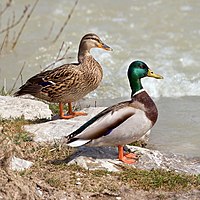
Photo from wikipedia
Intraspecific colour polymorphisms (CPs) present unique opportunities to study fundamental evolutionary questions, such as the link between ecology and phenotype, mechanisms maintaining genetic diversity and their putative role in speciation.… Click to show full abstract
Intraspecific colour polymorphisms (CPs) present unique opportunities to study fundamental evolutionary questions, such as the link between ecology and phenotype, mechanisms maintaining genetic diversity and their putative role in speciation. Wrasses are highly diverse in ecology and morphology and harbour a variety of colour‐polymorphic species. In the Mediterranean Sea, wrasses of the tribe Labrini evolved two species radiations each harbouring several species with a brown and a green morph. The colour morphs occur in complete sympatry in mosaic habitats with rocky outcrops and Neptune grass patches. Morph‐specific differences had not been characterized yet and the evolutionary forces maintaining them remained unknown. With genome‐wide data for almost all Labrini species, we show that species with CPs are distributed across the phylogeny, but show evidence of hybridization. This suggests that the colour morphs are either ancient and have been lost repeatedly, that they have evolved repeatedly or have been shared via hybridization. Focusing on two polymorphic species, we find that each colour morph is more common in the microhabitat providing the best colour match and that the morphs exhibit additional behavioural and morphological differences further improving crypsis in their respective microhabitats. We find little evidence for genetic differentiation between the morphs in either species. Therefore, we propose that these colour morphs represent a multi‐niche polymorphism as an adaptation to the highly heterogeneous habitat. Our study highlights how colour polymorphism (CP) can be advantageous in mosaic habitats and that Mediterranean wrasses are an ideal system to study trans‐species polymorphisms, i.e. polymorphisms maintained across several species, in adaptive radiations.
Journal Title: Journal of Evolutionary Biology
Year Published: 2022
Link to full text (if available)
Share on Social Media: Sign Up to like & get
recommendations!